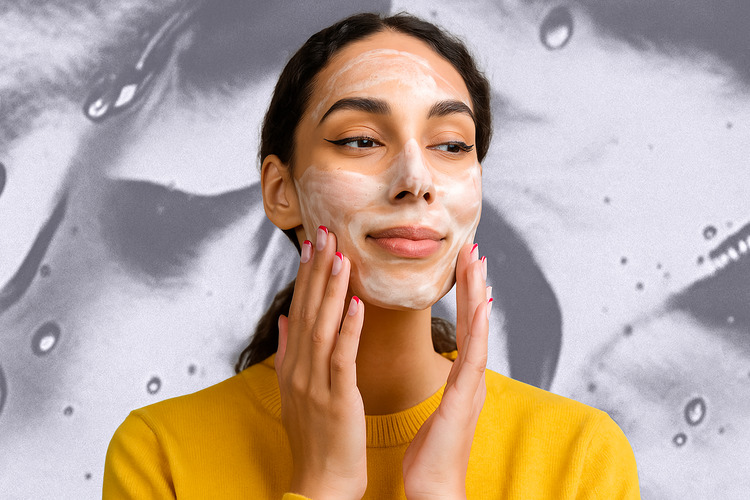If you’re passionate about beauty, you’re probably familiar with the seasonal update of your look. As autumn and winter arrive, lipsticks shift from soft pinks, peaches, and neutral shades to deeper tones: rich reds, burgundies, and browns. Nail polishes also transform, with light and airy colors giving way to bold and striking hues. Sometimes even familiar hairstyles change.
However, some elements of your beauty routine remain constant—your favorite shower gel or signature perfume, for instance. But should you adjust your skincare routine according to the season? This question has long been discussed online. Keep reading to learn what dermatologists recommend.
How Seasons Affect the Skin
Each season impacts the skin differently. If you’ve noticed that your usual products are less effective, there’s a reason for it. In spring and summer, when the weather is warm and humid, the skin retains more moisture but simultaneously produces more sebum, which can lead to clogged pores. Increased sweating can also worsen these issues.
High humidity and perspiration may trigger flare-ups of conditions such as dyshidrotic eczema or acne. Even regular use of sunscreen, while essential for skin protection, can sometimes cause breakouts in people with sensitive or problematic skin. Additionally, summer heat and sun exposure can exacerbate melasma, and folliculitis often occurs during this period due to inflammation of hair follicles caused by heat and sweat.
In autumn and winter, the skin is especially sensitive to temperature fluctuations. During transitional seasons, sudden changes in weather can cause the skin to alternate between dryness and increased oiliness, while in the cold months, moisture loss through the epidermis intensifies.
Transitional seasons, such as autumn and spring, are particularly challenging for the skin: abrupt shifts in temperature—from cold to warm—can make the skin dry on some days and oilier on others. This increases the risk of irritation and breakouts. In winter, dry cold air, low humidity, hot showers, heaters, and wool clothing further dehydrate the skin.
If you have skin conditions—such as eczema, psoriasis, or acne—moisture loss without proper restoration can trigger flare-ups. The skin becomes more inflamed and sensitive, creating an endless cycle of scratching and irritation, which increases the risk of scarring and dark spots.
Should you change your skincare routine with the new season?
Yes, your skincare routine should adapt to the climate. How exactly to do this depends on the season and your location, but in most cases, it’s enough to replace at least one key product.
In cities with pronounced seasonal changes, a complete overhaul of your skincare products is usually unnecessary. However, changing your moisturizer becomes essential.
In spring and summer, it’s best to choose a lightweight cream—such as a gel or water-based formula. Pay attention to the ingredients: if water or glycerin is listed at the beginning of the ingredient list, it means their concentration is higher than the other components, which indicates that the product effectively hydrates the skin.
How to Adjust Your Skincare Routine for Each Season
Autumn
Gradually introduce moisturizing cleansers and creams.
Gradually introduce moisturizing cleansers and creams.
Use richer, more nourishing moisturizers with high levels of occlusives and barrier-strengthening ingredients, such as ceramides. They help reduce transepidermal water loss and keep the skin hydrated for longer. Particularly effective are shea butter, coconut and jojoba oils, as well as squalane.
Winter
Cold weather makes the skin drier and more sensitive. Boost your routine with a nourishing cream and a gentle cleanser.
Pay attention to products for sensitive skin or skin prone to eczema—they help minimize irritation. If you use a retinol serum, pair it with a nourishing cream or choose a cream that already contains retinol.
Spring
Hot weather increases sweating and skin oiliness, making a simple, minimalist routine especially important.
For oily or acne-prone skin, it’s better to replace creamy cleansers with a gel or foam—they help control excess sebum and prevent breakouts.
Summer
Hot weather increases sweating and skin oiliness, making a simple, minimalist routine especially important.
Use gentle cleansers with exfoliants, such as AHAs or BHAs, and lightweight gel or water-based moisturizers. This routine helps prevent clogged pores, which is particularly important for acne-prone skin.
⸻
The best way to adjust your skincare is to carefully observe how your skin reacts in different seasons. Many targeted products, such as serums and retinols, are safe to use year-round, so usually, it’s enough to simply switch your cleanser or moisturizer to protect your skin from environmental factors. If you’re not achieving the desired results, consult a dermatologist—an expert can ensure your routine is properly tailored and provides maximum benefit.
Global Fashion offers a wide range of facial care products. You can easily choose the ones that suit your skin and help maintain its health all year round.
Global Fashion offers a wide range of facial care products. You can easily choose the ones that suit your skin and help maintain its health all year round.


